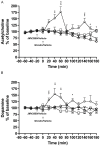Concomitant release of ventral tegmental acetylcholine and accumbal dopamine by ghrelin in rats
- PMID: 23166710
- PMCID: PMC3498203
- DOI: 10.1371/journal.pone.0049557
Concomitant release of ventral tegmental acetylcholine and accumbal dopamine by ghrelin in rats
Abstract
Ghrelin, an orexigenic peptide, regulates energy balance specifically via hypothalamic circuits. Growing evidence suggest that ghrelin increases the incentive value of motivated behaviours via activation of the cholinergic-dopaminergic reward link. It encompasses the cholinergic afferent projection from the laterodorsal tegmental area (LDTg) to the dopaminergic cells of the ventral tegmental area (VTA) and the mesolimbic dopamine system projecting from the VTA to nucleus accumbens (N.Acc.). Ghrelin receptors (GHS-R1A) are expressed in these reward nodes and ghrelin administration into the LDTg increases accumbal dopamine, an effect involving nicotinic acetylcholine receptors in the VTA. The present series of experiments were undertaken directly to test this hypothesis. Here we show that ghrelin, administered peripherally or locally into the LDTg concomitantly increases ventral tegmental acetylcholine as well as accumbal dopamine release. A GHS-R1A antagonist blocks this synchronous neurotransmitter release induced by peripheral ghrelin. In addition, local perfusion of the unselective nicotinic antagonist mecamylamine into the VTA blocks the ability of ghrelin (administered into the LDTg) to increase N.Acc.-dopamine, but not VTA-acetylcholine. Collectively our data indicate that ghrelin activates the LDTg causing a release of acetylcholine in the VTA, which in turn activates local nicotinic acetylcholine receptors causing a release of accumbal dopamine. Given that a dysfunction in the cholinergic-dopaminergic reward system is involved in addictive behaviours, including compulsive overeating and alcohol use disorder, and that hyperghrelinemia is associated with such addictive behaviours, ghrelin-responsive circuits may serve as a novel pharmacological target for treatment of alcohol use disorder as well as binge eating.
Conflict of interest statement
Figures


Similar articles
-
Ghrelin and GHS-R1A signaling within the ventral and laterodorsal tegmental area regulate sexual behavior in sexually naïve male mice.Psychoneuroendocrinology. 2015 Dec;62:392-402. doi: 10.1016/j.psyneuen.2015.09.009. Epub 2015 Sep 10. Psychoneuroendocrinology. 2015. PMID: 26398679
-
Ethanol elevates accumbal dopamine levels via indirect activation of ventral tegmental nicotinic acetylcholine receptors.Eur J Pharmacol. 2003 Apr 25;467(1-3):85-93. doi: 10.1016/s0014-2999(03)01564-4. Eur J Pharmacol. 2003. PMID: 12706460
-
Ghrelin administration into tegmental areas stimulates locomotor activity and increases extracellular concentration of dopamine in the nucleus accumbens.Addict Biol. 2007 Mar;12(1):6-16. doi: 10.1111/j.1369-1600.2006.00041.x. Addict Biol. 2007. PMID: 17407492
-
Role of ghrelin in drug abuse and reward-relevant behaviors: a burgeoning field and gaps in the literature.Curr Drug Abuse Rev. 2013 Sep;6(3):231-44. doi: 10.2174/1874473707666140205200532. Curr Drug Abuse Rev. 2013. PMID: 24502454 Review.
-
The role of the central ghrelin system in reward from food and chemical drugs.Mol Cell Endocrinol. 2011 Jun 20;340(1):80-7. doi: 10.1016/j.mce.2011.02.017. Epub 2011 Feb 24. Mol Cell Endocrinol. 2011. PMID: 21354264 Review.
Cited by
-
Ghrelin decreases sensitivity to negative feedback and increases prediction-error related caudate activity in humans, a randomized controlled trial.Neuropsychopharmacology. 2024 May;49(6):1042-1049. doi: 10.1038/s41386-024-01821-6. Epub 2024 Feb 26. Neuropsychopharmacology. 2024. PMID: 38409282 Free PMC article. Clinical Trial.
-
Off the beaten path: drug addiction and the pontine laterodorsal tegmentum.ISRN Neurosci. 2013 Jun 23;2013:604847. doi: 10.1155/2013/604847. eCollection 2013. ISRN Neurosci. 2013. PMID: 24959564 Free PMC article. Review.
-
Amylin Acts in the Lateral Dorsal Tegmental Nucleus to Regulate Energy Balance Through Gamma-Aminobutyric Acid Signaling.Biol Psychiatry. 2017 Dec 1;82(11):828-838. doi: 10.1016/j.biopsych.2016.12.028. Epub 2017 Jan 10. Biol Psychiatry. 2017. PMID: 28237459 Free PMC article.
-
Ghrelin and nicotine stimulate equally the dopamine release in the rat amygdala.Neurochem Res. 2013 Oct;38(10):1989-95. doi: 10.1007/s11064-013-1105-1. Epub 2013 Jul 9. Neurochem Res. 2013. PMID: 23836294
-
Peripherally circulating ghrelin does not mediate alcohol-induced reward and alcohol intake in rodents.Alcohol Clin Exp Res. 2014 Apr;38(4):959-68. doi: 10.1111/acer.12337. Epub 2014 Jan 15. Alcohol Clin Exp Res. 2014. PMID: 24428428 Free PMC article.
References
-
- Jerlhag E, Egecioglu E, Dickson SL, Andersson M, Svensson L, et al. (2006) Ghrelin stimulates locomotor activity and accumbal dopamine-overflow via central cholinergic systems in mice: implications for its involvement in brain reward. Addiction Biology 11: 45–54. - PubMed
-
- Larsson A, Engel JA (2004) Neurochemical and behavioral studies on ethanol and nicotine interactions. Neuroscience and Biobehavioral Reviews 27: 713–720. - PubMed
-
- Blaha CD, Allen LF, Das S, Inglis WL, Latimer MP, et al. (1996) Modulation of dopamine efflux in the nucleus accumbens after cholinergic stimulation of the ventral tegmental area in intact, pedunculopontine tegmental nucleus-lesioned, and laterodorsal tegmental nucleus-lesioned rats. J Neurosci 16: 714–722. - PMC - PubMed
-
- Engel JA, Fahlke C, Hulthe P, Hard E, Johannessen K, et al. (1988) Biochemical and behavioral evidence for an interaction between ethanol and calcium-channel antagonists. Alcohol and Alcoholism 23: A13–A13. - PubMed
-
- Wise RA, Rompre PP (1989) Brain dopamine and reward. Annu Rev Psychol 40: 191–225. - PubMed
Publication types
MeSH terms
Substances
LinkOut - more resources
Full Text Sources

